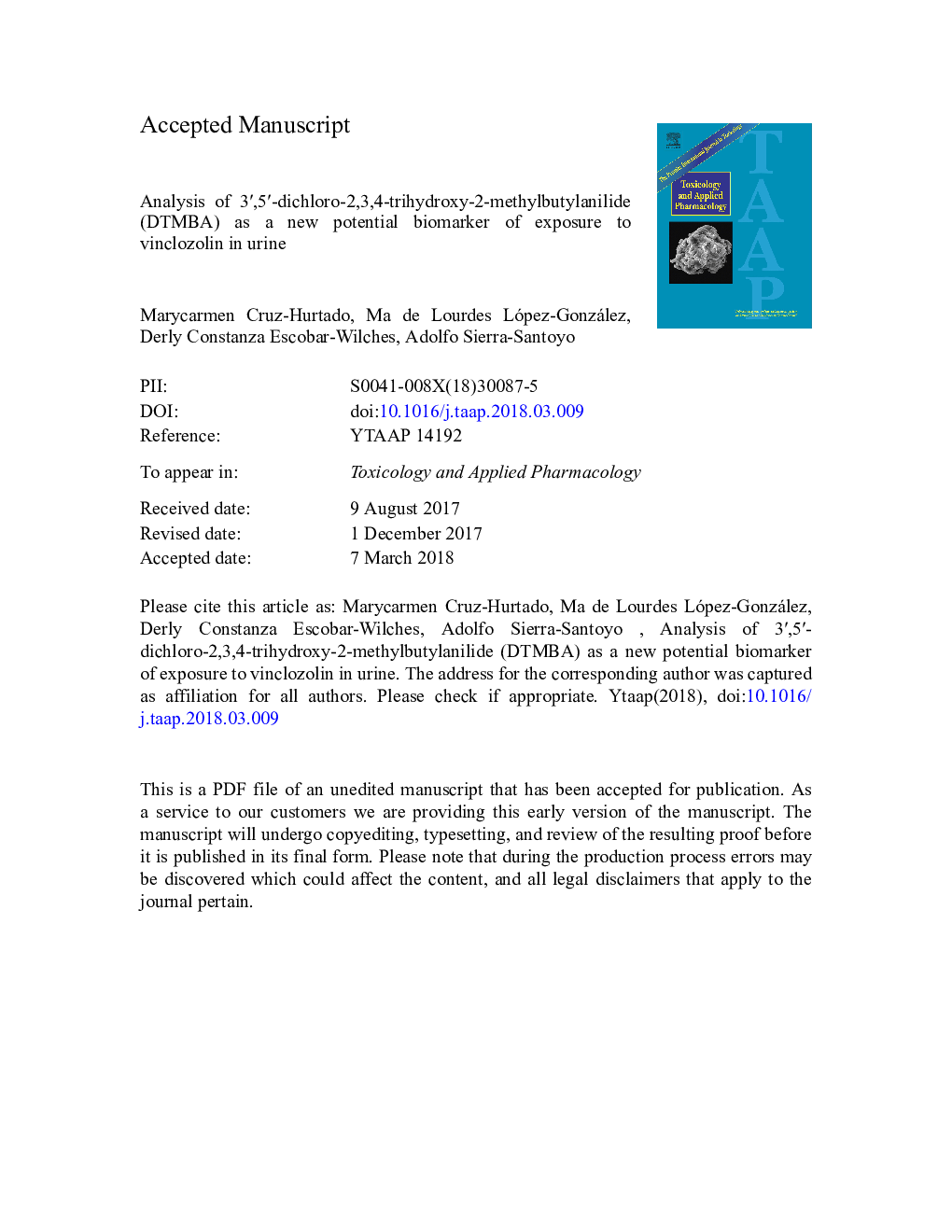| کد مقاله | کد نشریه | سال انتشار | مقاله انگلیسی | نسخه تمام متن |
|---|---|---|---|---|
| 8538643 | 1561116 | 2018 | 30 صفحه PDF | دانلود رایگان |
عنوان انگلیسی مقاله ISI
Analysis of 3â²,5â²-dichloro-2,3,4-trihydroxy-2-methylbutylanilide (DTMBA) as a new potential biomarker of exposure to vinclozolin in urine
دانلود مقاله + سفارش ترجمه
دانلود مقاله ISI انگلیسی
رایگان برای ایرانیان
کلمات کلیدی
موضوعات مرتبط
علوم زیستی و بیوفناوری
علوم محیط زیست
بهداشت، سم شناسی و جهش زایی
پیش نمایش صفحه اول مقاله

چکیده انگلیسی
Vinclozolin (V) is a fungicide with anti-androgenic properties whose metabolism is not fully understood, and data on urinary elimination of either V or its metabolites are limited. Therefore the kinetics of urinary elimination of V and its metabolites, after an oral dose in adult male rats were investigated. A single oral dose of V (100â¯mg/kg) suspended in corn oil was administered to male adult Wistar rats, and urine was collected at different times after dosing. V and its metabolites were extracted from urine, then enzymatically hydrolyzed using β-glucuronidase/sulfatase of H. pomatia, and analyzed by HPLC/DAD. Urinary pharmacokinetic parameters were calculated using the analyte concentrations adjusted by creatinine levels. V and its metabolites 3â²,5â²-dichloro-2,3,4-trihydroxy-2-methylbutylanilide (DTMBA, formerly denoted as M5), 2-[[(3,5-dichlorophenyl)-carbamoyl]oxy]-2-methyl-3-butenoic acid (M1), 3,5-dichloroaniline (M3), and 3â²,5â²-dichloro-2-hydroxy-2-methylbut-3-enanilide (M2) were efficiently detected. The mean urine concentrations of V and M1 metabolite were fitted to a two-compartmental model for pharmacokinetic analysis. DTMBA approximately represented 88% of the total excreted metabolites, it was easily detected up to 168â¯h after dosing and its half-lives were 21.5 and 74.1â¯h, respectively. M1 was the second most abundant metabolite and was detected up to 144â¯h after being void. V and M3 were detected before 48â¯h, and M2 exhibited the lowest levels during the first 8â¯h after dosing. DTMBA, the most abundant V metabolite is quickly eliminated by urine, it is chemically stable, specific and could represent a useful alternative to be used as a biomarker of exposure to V.
ناشر
Database: Elsevier - ScienceDirect (ساینس دایرکت)
Journal: Toxicology and Applied Pharmacology - Volume 346, 1 May 2018, Pages 1-8
Journal: Toxicology and Applied Pharmacology - Volume 346, 1 May 2018, Pages 1-8
نویسندگان
Marycarmen Cruz-Hurtado, Ma. de Lourdes López-González, Derly Constanza Escobar-Wilches, Adolfo Sierra-Santoyo,